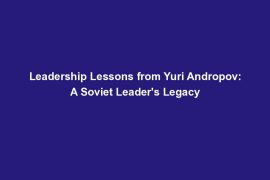Hey there, have you ever wondered what we can learn about leadership from historical figures like Joseph Stalin? It might seem like an unlikely source of inspiration, but studying the leadership tactics of controversial leaders can actually provide some valuable insights that we can apply to our own lives. In this blog post, we’re going to dive into the world of Joseph Stalin’s leadership during the Soviet Union, analyze his leadership style and practices, and pull out some key lessons that we can all learn from.
So, who was Joseph Stalin and why is he even worth studying? Well, Stalin was a key figure in the Soviet Union during the early to mid-20th century, and his leadership style was characterized by a ruthless authoritarian rule. By understanding how he managed to maintain power and control, we can gain a deeper understanding of the complexities of leadership and the impact it can have on a nation and its people.
In this post, we’ll explore how Stalin cultivated a cult of personality and used propaganda to bolster his image and influence. We’ll also delve into his decision-making process and how his authoritarian leadership style shaped the course of history. Lastly, we’ll look at how Stalin manipulated power dynamics within the Soviet government and Communist Party, and what lessons we can glean from this in terms of understanding leadership and its consequences.
So, get ready to uncover some unexpected but intriguing leadership lessons from Joseph Stalin’s controversial reign. Stay tuned for some eye-opening insights that just might change the way you think about leadership. Let’s dive in!
Cultivating a Cult of Personality and Propaganda
One of the most striking aspects of Joseph Stalin’s leadership style was his ability to cultivate a cult of personality through the use of propaganda. Imagine being bombarded with images and messages glorifying your leader, depicting him as a hero and a savior. This was the reality for the people of the Soviet Union during Stalin’s rule.
Stalin carefully crafted his image to appear as an omnipotent and benevolent figure, someone to be revered and feared at the same time. His cult of personality was everywhere, from posters in the streets to songs praising his greatness. This constant reinforcement of his power and authority helped him maintain control over the population and instill loyalty among his followers.
However, this manipulation of public perception had dark consequences. People were conditioned to believe in Stalin’s infallibility, leading to a climate of fear and obedience. Dissent was crushed mercilessly, as anyone who dared to question the leader risked being labeled an enemy of the state. The impact of this propaganda machine on the psyche of the Soviet people cannot be overstated.
Ruthless Decision-Making and Authoritarian Rule
Stalin’s authoritarian leadership style was characterized by his ruthless decision-making and absolute control over the Soviet Union. Imagine a leader who brooks no opposition and demands unwavering loyalty from his subordinates. This was Stalin in a nutshell.
His authoritarian rule meant that he was the ultimate decision-maker, with no checks or balances to curb his power. This unchecked authority allowed Stalin to implement policies and make decisions that had far-reaching consequences for the Soviet Union and its people.
Stalin’s ruthless actions, such as the widespread purges and collectivization campaigns, caused immense suffering and loss of life. His iron-fisted rule left a legacy of fear and repression that haunted the Soviet Union for decades to come. The lesson here is clear: unchecked power can lead to disastrous outcomes for both the leader and their followers.
Manipulation of Power Dynamics and Control
Stalin was a master manipulator of power dynamics within the Soviet government and Communist Party. Imagine a leader who plays different factions against each other, consolidating power in his own hands while keeping his enemies at bay. This was Stalin’s modus operandi.
By sowing discord and mistrust among his rivals, Stalin ensured that he remained the dominant force in the Soviet Union. He skillfully used patronage and coercion to maintain control over key positions of power, effectively neutralizing any potential threats to his authority.
Understanding power dynamics in leadership is crucial, as it can make or break a leader’s effectiveness. The lesson from Stalin’s manipulation of power dynamics is clear: power can be a double-edged sword, capable of both advancing a leader’s agenda and causing untold harm if wielded irresponsibly.
With these key leadership lessons from Joseph Stalin in mind, it’s important to reflect on how they apply to contemporary leadership practices. Stay tuned for the next section, where we’ll delve into the implications of applying these lessons to today’s leaders and organizations.
Conclusion: Reflecting on Stalin’s Leadership Lessons
As we wrap up our analysis of Joseph Stalin’s leadership style, it’s important to reflect on the key lessons that can be learned from his controversial reign. Despite the atrocities committed under his rule, there are valuable insights that can be gleaned from studying his leadership tactics.
Recap of Key Leadership Lessons
One of the most prominent lessons from Stalin’s leadership is the power of cultivating a cult of personality and using propaganda to maintain control. By glorifying himself and suppressing dissent through propaganda, Stalin was able to wield immense power over his followers and the general population. This teaches us the importance of being skeptical of leaders who rely heavily on propaganda and personality cults for support.
Another crucial lesson from Stalin’s leadership is the danger of ruthless decision-making and authoritarian rule. His oppressive tactics led to devastating consequences for the Soviet Union and its people. This serves as a stark reminder of the negative impact that a leader’s unchecked power can have on a society.
Furthermore, Stalin’s manipulation of power dynamics within the Soviet government and Communist Party underscores the importance of understanding power dynamics in leadership. By exploiting and controlling these dynamics, he was able to consolidate his power and eliminate potential threats to his rule. This highlights the need for transparency and accountability in leadership to prevent abuse of power.
Implications for Contemporary Leadership
While Stalin’s leadership style may seem extreme and unethical, there are still valuable lessons that can be applied to contemporary leadership practices. By studying historical figures like Stalin, we can gain a deeper understanding of the complexities of leadership and the potential pitfalls to avoid.
It is crucial for leaders today to engage in critical thinking and discussion about the lessons that can be learned from past leaders like Stalin. By reflecting on his leadership style, we can strive to promote ethical and responsible leadership practices that prioritize the well-being of individuals and society as a whole.
So, let’s continue to delve into the complexities of leadership, learn from the mistakes of the past, and strive to be better leaders for the future. By doing so, we can create a more just and equitable world for generations to come.



